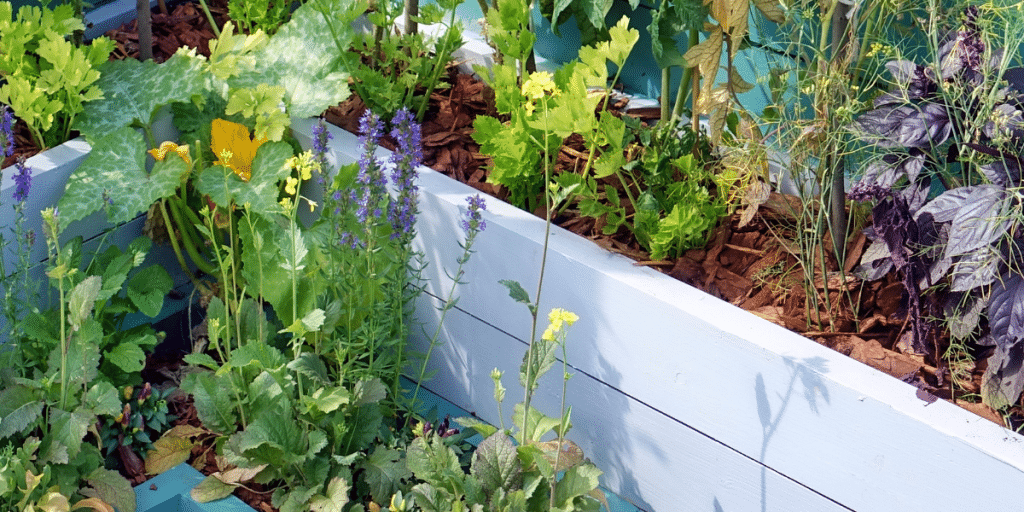Urban living has its perks, from the convenience of city amenities to the vibrant culture, but it often comes at the cost of a lack of greenery. However, miniature gardening is changing the game. It offers a creative and practical solution for urban dwellers yearning to reconnect with nature.
This blog is the answer for those living in city apartments or homes with limited outdoor space. We'll delve into the simplicity and charm of miniature gardens. Explore the benefits they bring to urban life, and offer tips and guides to help you get started on your own miniature gardening journey.
This urban gardening trend is perfect for anyone looking to bring a touch of nature into their place. So, let's dive into the world of miniature gardening and discover how it can transform your urban living experience.
What is Miniature Gardening
Miniature gardening is the art of creating tiny, enchanting landscapes using small plants, decorative structures, and detailed accessories. It's like building a magical world in a small container or space. Think of it as designing a little fairy tale garden, where everything is scaled down, making it perfect for balconies, patios, or even indoors, allowing everyone, especially city dwellers, to enjoy a touch of greenery and grow food at home.
What are the Benefits of Miniature Gardening
1. Space-Saving Solution:
In today's urban environments, space is a luxury many can't afford. Traditional gardens require yards and large plots, but with miniature gardening, that's not the case. These tiny landscapes fit perfectly on balconies, windowsills, and even tabletops. So, even if you're in a high-rise apartment with no yard in sight, a miniature garden can bring the joys of gardening right to your living room.
2. Enhances Creativity:
Miniature gardening isn't just about plants; it's about designing an entire tiny world. From picking the right miniature benches and pathways to deciding on the tiniest of fairy dwellings, it gives you an outlet to express creativity. Every mini garden is a story waiting to be told, and you're the storyteller. It's a hobby that constantly inspires and evolves, sparking imagination at every turn.
3. Therapeutic Benefits:
Gardening has long been recognized for its therapeutic qualities. It's meditative, and grounding, and brings us back to nature. With miniature gardening, this therapy is condensed into a manageable form. Caring for your mini oasis can help reduce stress, increase mindfulness, and provide a sense of accomplishment. It's a small, personal world where you can escape and find tranquility.
4. Eco-Friendly & Sustainable Gardening:
By its very nature, miniature gardening is resource-efficient. It requires less water, fewer fertilizers, and less soil than traditional gardens. Plus, many enthusiasts opt for native or drought-resistant plants, further reducing the ecological footprint. In a world where sustainability is key, these tiny gardens are a testament to the fact that green living can start in the smallest of spaces.
Creating a miniature garden can be quite economical. Many of the items used can be recycled materials or things you already have around the house. Plus, because of its size, it requires less water and resources than traditional gardening.
5. Versatile & Adaptable:
The beauty of miniature gardening lies in its adaptability. Seasons change? So can your garden! Want to incorporate a new theme? It's easy to switch things up. Whether you're captivated by the charm of fairy gardens, zen-inspired Japanese miniature landscapes, or even mini deserts with cacti and sand, there's a miniature garden to match every mood and preference.
6. Low Maintenance, Big Rewards
The beauty of miniature gardens isn't just their size. They are relatively easy to maintain. With fewer plants and a smaller space to manage, even those with the busiest of schedules can find time to tend to their garden.
7. Environmental Benefits
Miniature gardens, though small in size, play a role in supporting urban biodiversity. They provide pockets of greenery that can support insects and improve air quality. In the heart of the city, it's easy to feel detached from nature. A miniature garden offers a slice of the natural world. Tending to these gardens can be therapeutic, grounding city dwellers and reminding them of the wonders of the natural world.
8. Quick Turnaround
Another appealing aspect is the quick growth cycle of miniature vegetables. Many dwarf vegetable varieties mature more quickly than their full-sized counterparts, meaning you'll get to harvest your produce sooner. This also allows for multiple planting cycles within a single growing season, increasing the amount of produce you can enjoy.
How to Create a Vegetable Miniature Garden
A vegetable miniature garden not only beautifies your space but also provides you with tiny, yet harvestable, vegetables. Here's a step-by-step guide to creating one.
1. Decide on the Location:
While most vegetable plants love sunlight, your miniature garden's size means it can be more versatile. Consider:
- Sunny windowsills: Perfect for plants like miniature tomatoes or peppers.
- Balconies or patios: Ideal if you’re going slightly larger in scale.
- Indoor grow lights: Suitable for year-round gardening.
2. Choose a Suitable Container:
- Raised wooden boxes: Allows for deep-rooted vegetables.
- Wide terracotta pots: Provide excellent breathability.
- Hanging baskets: Great for trailing plants like mini cucumbers.
3. Prep the Soil:
Opt for a rich, organic potting mix. Adding some compost or well-rotted manure can give your tiny vegetables a nutrient boost.
4. Pick Your Miniature Vegetables:
There are many dwarf varieties available. Some options include:
- Tomatoes: Such as ‘Tiny Tim' or ‘Tumbling Tom'.
- Radishes: Try ‘Babette' or other small varieties.
- Carrots: ‘Little Finger' or ‘Paris Market'.
- Lettuce: Opt for cut-and-come-again types.
- Peppers: ‘Mini Bell' varieties work well.
5. Plan the Layout:
Remember to consider the growth pattern and space requirements. Place taller plants like tomatoes at the back or center, with shorter ones like radishes in the front.
6. Planting Time:
Ensure you make small holes deep enough for the vegetable seeds or seedlings. Once planted, press the soil gently around them.
7. Water Wisely:
While it's essential to keep the soil moist, be wary of overwatering. Use a misting spray or a watering can with a fine rose to avoid displacing the soil.
8. Add Support Structures:
Even in miniature form, some vegetables like tomatoes might need support. Consider tiny bamboo sticks or make DIY trellises.
9. Keep an Eye Out for Pests:
Just like a regular vegetable garden, pests can be an issue. Inspect regularly for signs of aphids, caterpillars, or other critters.
Bonus Tip: Enhance your garden’s appeal by adding small garden tools, tiny scarecrows, or even miniature garden signs labeling each vegetable.
Creating a vegetable miniature garden is not only about producing food; it's an art and a testament to how you can maximize minimal spaces.
Basic Tools and Supplies for Vegetable Miniature Gardening
Miniature vegetable gardening, while petite in scale, requires some essential tools to make the process smooth, efficient, and enjoyable. Whether you're just starting out or looking to enhance your existing setup, here are the basic tools you'll need:
Miniature Trowel:
A trowel is one of the most essential tools for vegetable miniature gardening. It resembles a mini shovel with a pointed tip, making it perfect for digging small holes, transferring plants, or adding soil to your container. Given the compact nature of miniature gardens, a trowel offers precision that larger gardening tools cannot. It helps in ensuring that plants are placed at the right depth, ensuring better growth and stability.
Pruning Shears (or Miniature Scissors)
Pruning shears, specifically designed for miniature gardening or tiny scissors, are a must-have for maintaining your little garden. As your vegetables grow, you'll need to trim and prune to keep everything in proportion and ensure productive growth. These shears allow for precise cuts, ensuring that you don't damage adjacent plants or disrupt the overall design of your garden.
Watering Can with a Narrow Spout
When watering your miniature vegetable garden, precision is crucial. A watering can with a narrow spout lets you direct water exactly where it's needed, preventing over-watering or waterlogging. Additionally, this design ensures that water reaches the roots of the plants without disturbing the surrounding soil or causing erosion.
Fine-Mist Spray Bottle
A fine-mist spray bottle is invaluable for vegetable miniature gardening. Given the delicate nature of young plants and seedlings, they often require a gentler touch when it comes to moisture. A spray bottle allows you to mist the plants, ensuring they receive the necessary hydration without overwhelming them. This tool is especially crucial in the early stages of plant growth.
Tweezers or Forceps
In a miniature garden, even the tiniest detail matters. Tweezers or forceps are the perfect tools for placing seeds, adjusting small plants, or even removing tiny weeds that sprout up. They provide the precision and control that fingers might not offer in such a confined space, ensuring every element of your garden is perfectly placed.
Soil Scoop
A soil scoop is a tool designed to help you transport and distribute soil within your miniature garden. Given the garden's small size, adding or replacing soil can be a delicate task. The scoop ensures that you can add just the right amount of soil without making a mess or disturbing the existing plants.
Flexible Wire or Plant Ties:
As your miniature vegetables grow, they might need a little support to maintain their shape or direction. Flexible wire or plant ties can be gently used to guide the growth without damaging the delicate plants, ensuring they grow in the desired manner within the confines of your miniature space.
Gloves
Gloves are a staple for any gardening activity, including vegetable miniature gardening. While handling tiny plants and accessories, gloves protect your hands from getting dirty and ensure a better grip. Additionally, they shield your skin from any irritants that might be present in the soil or on the plants. For miniature gardening, opt for gloves that are flexible and offer a snug fit to ensure you can handle even the smallest details with precision and care.
Nutrient Mix Soil and Compost
For a miniature vegetable garden to thrive, the right type of soil is imperative. Fine-grained soil ensures that the tiny plant roots can easily spread and anchor themselves, while also retaining the right amount of moisture. On the other hand, compost adds much-needed nutrients to the soil, ensuring that your miniature vegetables get all the nourishment they need to grow. Integrating a blend of fine-grained soil and rich compost creates the perfect bed for your mini plants, promoting healthy growth and yielding a bountiful miniature harvest.
Conclusion:
In an age where urban spaces are shrinking, our connection to nature seems to be dwindling. Vegetable miniature gardening emerges as a beacon of hope. It's not just about cultivating tiny landscapes, but also about harvesting fresh, home-grown produce right in the heart of the city. This innovative approach to gardening bridges the gap between aesthetics and functionality. It allows us to enjoy the dual joys of greenery and fresh food, even within the tiny spaces of the city.
So, if you're an urban dweller searching for that perfect blend of beauty, sustainability, and nutrition. Dive into the world of vegetable miniature gardening and watch as your little space transforms into a haven of fresh produce and enchantment.

